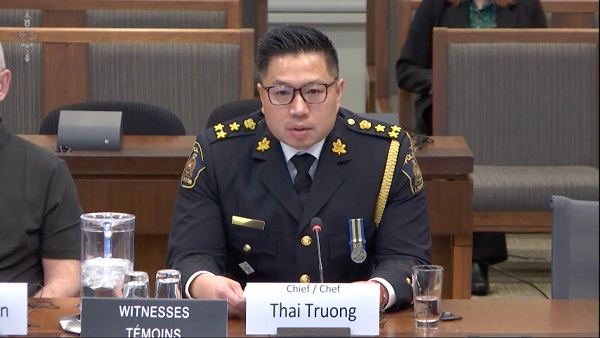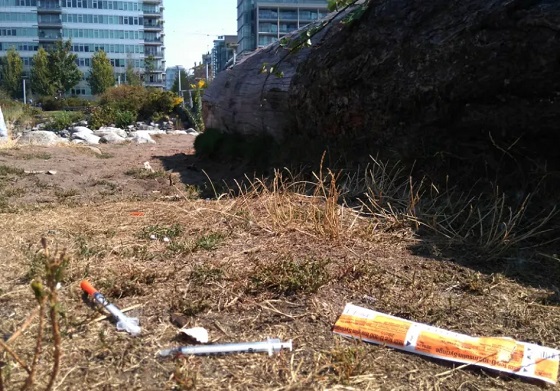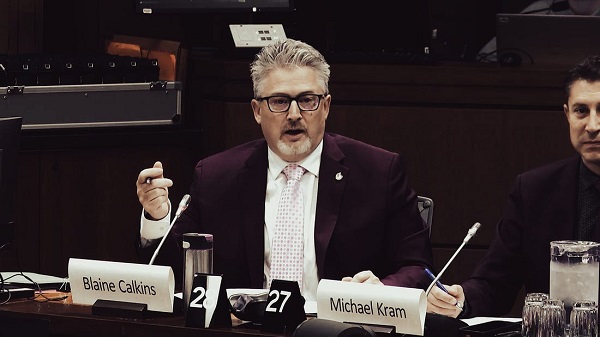Addictions
London Police Chief warns parliament about “safer supply” diversion

London Police Chief Thai Truong testifies to House of Commons Standing Committee on November 26, 2024.
By Adam Zivo
“Vulnerable individuals are being targeted by criminals who exchange these prescriptions for fentanyl, exacerbating addiction and community harm,” said London Police Chief Thai Truong.
Thai Truong, the police chief of London, Ontario, testified in parliament last week that “safer supply” opioids are “obviously” being widely diverted to the black market, leading to greater profits for organized crime. His insights further illustrate that the safer supply diversion crisis is not disinformation, as many harm reduction advocates have speciously claimed.
Truong’s testimony was given to the House of Commons Standing Committee on Health, which is in the midst of an extended study into the opioid crisis. While the committee has heard from dozens of witnesses, Truong’s participation was particularly notable, as safer supply was first piloted in London in 2016 and the city has, since then, been a hotbed for opioid diversion.
“While the program is well intentioned, we are seeing concerning outcomes related to the diversion of safe supply medications… these diverted drugs are being resold within our community, trafficked to other jurisdictions, and even used as currency to obtain fentanyl, perpetuating the illegal drug trade,” he said in his opening speech. “Vulnerable individuals are being targeted by criminals who exchange these prescriptions for fentanyl, exacerbating addiction and community harm.”
He later clarified to committee members that these vulnerable individuals include women who are being pressured to obtain safer supply opioids for black market resale.
Safer supply programs are supposed to provide pharmaceutical-grade addictive drugs – mostly 8-mg tablets of hydromorphone, an opioid as potent as heroin – as an alternative to riskier street substances. The programs generally supply these drugs at no cost to recipients, with almost no supervised consumption, and have a strong preference for Dilaudid, a brand of hydromorphone that is manufactured by Purdue Pharma.
Addiction experts and police leaders across Canada have reported that safer supply patients regularly divert their hydromorphone to the black market. A recent study by Dr. Brian Conway, director of Vancouver’s Infectious Disease Centre, for example, showed that a quarter of his safer supply patients diverted all of their hydromorphone, and that another large, but unknown, percentage diverted at least some of their pills.
Truong’s parliamentary testimony, which mostly rehashed information he shared in a press conference last July, further corroborated these concerns.
He noted that in 2019, the city’s police force seized 847 hydromorphone pills, of which only 75 were 8-mg Dilaudids. Seizures increased after access to safer supply expanded in 2020, and, by 2023, exploded to over 30,000 pills (a roughly 3,500 per cent increase), of which roughly half were 8-mg Dilaudids. During this period, the number of annual overdose deaths in the city also increased from 73 to 123 (a 68 per cent increase), he said.
Relatedly, Truong noted that the price of hydromorphone in London – $2-5 a pill – is now much lower than in other parts of the province.
As an increasing number of police departments across Canada have publicly acknowledged that they are seeing skyrocketing hydromorphone seizures, some safer supply advocates have claimed, without evidence, that these pills were mostly stolen from pharmacies, and not diverted by safer supply patients. Truong’s parliamentary testimony dispelled this myth: “These increases cannot be attributed to pharmacy thefts, as London has had only one pharmacy robbery since 2019.”
The police chief declined to answer repeated questions about the efficacy of safer supply, or to opine on whether the experimental program should be replaced with alternative interventions with stronger evidence bases. “I’m not here to criticize the safe supply program, but to address the serious challenges associated with its diversion,” he said, noting his own lack of medical expertise.
The chief emphasized that, while more needs to be done to stop safer supply diversion, the addiction crisis is a “complex issue” that cannot be tackled solely through law enforcement. He advocated for a “holistic” approach that integrates prevention, harm reduction and treatment, and acknowledged the importance of London’s community health and social service partners.
Our content is always free. Subscribe to get BTN’s latest news and analysis,
or donate to our journalism fund.
In response to Truong’s testimony, NDP MP Gord Johns, an avid safer supply advocate, downplayed the importance of the diversion crisis by arguing that “people aren’t dying from a safer supply of drugs; they’re dying from fentanyl.”
While it is true that 81 per cent of overdose deaths in 2024 involved fentanyl, addiction physicians across Canada have repeatedly debunked Johns’ argument as misleading. The dangers of diverted hydromorphone is not that it directly kills users, but rather that it easily hooks individuals into addiction, leading many of them to graduate to deadly fentanyl use.
Johns previously faced criticism when, in a September health committee meeting, he seemingly used parliamentary maneuvers to reduce the speaking time of a grieving father, Greg Sword, whose daughter, Kamilah, died of drug-related causes after she and her friends got hooked on diverted hydromorphone.
There is currently no credible evidence that safer supply works. Most supporting studies simply interview safer supply patients and present their opinions as objective fact, despite significant issues with bias and reliability. Data presented in a 2024 study published in the British Medical Journal, which followed over 5,000 drug users in B.C., showed that safer supply led to no statistically significant mortality reductions once confounding factors were fully filtered out.
An impending update to Canada’s National Opioid Use Disorder Guideline, which was recently presented at a conference organized by the Canadian Society of Addiction Medicine, determined that the evidence base for safer supply is “essentially low-level.” Similarly, B.C’s top doctor acknowledged earlier this year that safer supply is “not fully evidence-based.”
This article was syndicated in The Bureau, an online media publication that investigates foreign interference, organized crime, and the drug trade.
Addictions
The Shaky Science Behind Harm Reduction and Pediatric Gender Medicine


By Adam Zivo
Both are shaped by radical LGBTQ activism and questionable evidence.
Over the past decade, North America embraced two disastrous public health movements: pediatric gender medicine and “harm reduction” for drug use. Though seemingly unrelated, these movements are actually ideological siblings. Both were profoundly shaped by extremist LGBTQ activism, and both have produced grievous harms by prioritizing ideology over high-quality scientific evidence.
While harm reductionists are known today for championing interventions that supposedly minimize the negative effects of drug consumption, their movement has always been connected to radical “queer” activism. This alliance began during the 1980s AIDS crisis, when some LGBTQ activists, hoping to reduce HIV infections, partnered with addicts and drug-reform advocates to run underground needle exchanges.
The Bureau is a reader-supported publication.
To receive new posts and support my work, consider becoming a free or paid subscriber.
In the early 2000s, after the North American AIDS epidemic was brought under control, many HIV organizations maintained their relevance (and funding) by pivoting to addiction issues. Despite having no background in addiction medicine, their experience with drug users in the context of infectious diseases helped them position themselves as domain experts.
These organizations tended to conceptualize addiction as an incurable infection—akin to AIDS or Hepatitis C—and as a permanent disability. They were heavily staffed by progressives who, influenced by radical theory, saw addicts as a persecuted minority group. According to them, drug use itself was not the real problem—only society’s “moralizing” norms.
These factors drove many HIV organizations to lobby aggressively for harm reduction at the expense of recovery-oriented care. Their efforts proved highly successful in Canada, where I am based, as HIV researchers were a driving force behind the implementation of supervised consumption sites and “safer supply” (free, government-supplied recreational drugs for addicts).
From the 2010s onward, the association between harm reductionism and queer radicalism only strengthened, thanks to the popularization of “intersectional” social justice activism that emphasized overlapping forms of societal oppression. Progressive advocates demanded that “marginalized” groups, including drug addicts and the LGBTQ community, show enthusiastic solidarity with one another.
These two activist camps sometimes worked on the same issues. For example, the gay community is struggling with a silent epidemic of “chemsex” (a dangerous combination of drugs and anonymous sex), which harm reductionists and queer theorists collaboratively whitewash as a “life-affirming cultural practice” that fosters “belonging.”
For the most part, though, the alliance has been characterized by shared tones and tactics—and bad epistemology. Both groups deploy politicized, low-quality research produced by ideologically driven activist-researchers. The “evidence-base” for pediatric gender medicine, for example, consists of a large number of methodologically weak studies. These often use small, non-representative samples to justify specious claims about positive outcomes. Similarly, harm reduction researchers regularly conduct semi-structured interviews with small groups of drug users. Ignoring obvious limitations, they treat this testimony as objective evidence that pro-drug policies work or are desirable.
Gender clinicians and harm reductionists are also averse to politically inconvenient data. Gender clinicians have failed to track long-term patient outcomes for medically transitioned children. In some cases, they have shunned detransitioners and excluded them from their research. Harm reductionists have conspicuously ignored the input of former addicts, who generally oppose laissez-faire drug policies, and of non-addict community members who live near harm-reduction sites.
Both fields have inflated the benefits of their interventions while concealing grievous harms. Many vulnerable children, whose gender dysphoria otherwise might have resolved naturally, were chemically castrated and given unnecessary surgeries. In parallel, supervised consumption sites and “safer supply” entrenched addiction, normalized public drug use, flooded communities with opioids, and worsened public disorder—all without saving lives.
In both domains, some experts warned about poor research practices and unmeasured harms but were silenced by activists and ideologically captured institutions. In 2015, one of Canada’s leading sexologists, Kenneth Zucker, was fired from the gender clinic he had led for decades because he opposed automatically affirming young trans-identifying patients. Analogously, dozens of Canadian health-care professionals have told me that they feared publicly criticizing aspects of the harm-reduction movement. They thought doing so could invite activist harassment while jeopardizing their jobs and grants.
By bullying critics into silence, radical activists manufactured false consensus around their projects. The harm reductionists insist, against the evidence, that safer supply saves lives. Their idea of “evidence-based policymaking” amounts to giving addicts whatever they ask for. “The science is settled!” shout the supporters of pediatric gender medicine, though several systematic reviews proved it was not.
Both movements have faced a backlash in recent years. Jurisdictions throughout the world are, thankfully, curtailing irreversible medical procedures for gender-confused youth and shifting toward a psychotherapy-based “wait and see” approach. Drug decriminalization and safer supply are mostly dead in North America and have been increasingly disavowed by once-supportive political leaders.
Harm reductionists and queer activists are trying to salvage their broken experiments, occasionally by drawing explicit parallels between their twin movements. A 2025 paper published in the International Journal of Drug Policy, for example, asserts that “efforts to control, repress, and punish drug use and queer and trans existence are rising as right-wing extremism becomes increasingly mainstream.” As such, there is an urgent need to “cultivate shared solidarity and action . . . whether by attending protests, contacting elected officials, or vocally defending these groups in hostile spaces.”
How should critics respond? They should agree with their opponents that these two radical movements are linked—and emphasize that this is, in fact, a bad thing. Large swathes of the public understand that chemically and surgically altering vulnerable children is harmful, and that addicts shouldn’t be allowed to commandeer public spaces. Helping more people grasp why these phenomena arose concurrently could help consolidate public support for reform and facilitate a return to more restrained policies.
Adam Zivo is director of the Canadian Centre for Responsible Drug Policy.
For the full experience, please upgrade your subscription and support a public interest startup.
We break international stories and this requires elite expertise, time and legal costs.
Addictions
BC premier admits decriminalizing drugs was ‘not the right policy’

From LifeSiteNews
Premier David Eby acknowledged that British Columbia’s liberal policy on hard drugs ‘became was a permissive structure that … resulted in really unhappy consequences.’
The Premier of Canada’s most drug-permissive province admitted that allowing the decriminalization of hard drugs in British Columbia via a federal pilot program was a mistake.
Speaking at a luncheon organized by the Urban Development Institute last week in Vancouver, British Columbia, Premier David Eby said, “I was wrong … it was not the right policy.”
Eby said that allowing hard drug users not to be fined for possession was “not the right policy.
“What it became was a permissive structure that … resulted in really unhappy consequences,” he noted, as captured by Western Standard’s Jarryd Jäger.
LifeSiteNews reported that the British Columbia government decided to stop a so-called “safe supply” free drug program in light of a report revealing many of the hard drugs distributed via pharmacies were resold on the black market.
Last year, the Liberal government was forced to end a three-year drug decriminalizing experiment, the brainchild of former Prime Minister Justin Trudeau’s government, in British Columbia that allowed people to have small amounts of cocaine and other hard drugs. However, public complaints about social disorder went through the roof during the experiment.
This is not the first time that Eby has admitted he was wrong.
Trudeau’s loose drug initiatives were deemed such a disaster in British Columbia that Eby’s government asked Trudeau to re-criminalize narcotic use in public spaces, a request that was granted.
Records show that the Liberal government has spent approximately $820 million from 2017 to 2022 on its Canadian Drugs and Substances Strategy. However, even Canada’s own Department of Health in a 2023 report admitted that the Liberals’ drug program only had “minimal” results.
Official figures show that overdoses went up during the decriminalization trial, with 3,313 deaths over 15 months, compared with 2,843 in the same time frame before drugs were temporarily legalized.
-

 Alberta1 day ago
Alberta1 day agoFrom Underdog to Top Broodmare
-

 Media23 hours ago
Media23 hours agoCarney speech highlights how easily newsrooms are played by politicians
-

 Business1 day ago
Business1 day agoThe painful return of food inflation exposes Canada’s trade failures
-

 Business5 hours ago
Business5 hours agoPaying for Trudeau’s EV Gamble: Ottawa Bought Jobs That Disappeared
-

 Business8 hours ago
Business8 hours agoCBC uses tax dollars to hire more bureaucrats, fewer journalists
-

 National6 hours ago
National6 hours agoElection Officials Warn MPs: Canada’s Ballot System Is Being Exploited
-

 International2 days ago
International2 days agoPrince Andrew banished from the British monarchy
-

 Business2 days ago
Business2 days ago“We have a deal”: Trump, Xi strike breakthrough on trade and fentanyl






